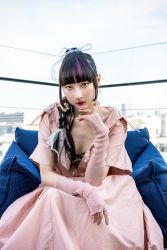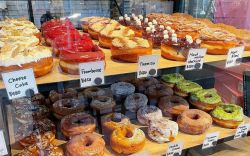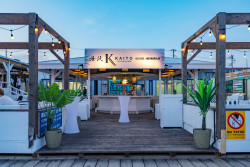
Originally published on metropolis.co.jp on July 2008

Yoshimoto Nara
You see the news almost every day—another record price paid for a piece of art. The rapidly developing interest in contemporary works, coupled with the perception of art as an investment, has seen rising numbers of new and moneyed buyers entering the market. “Cash ready” collectors are lining up at the doors of major international art fairs like the recent Art Basel, where buyers of blue chip art were snapping up Japanese works.
Until recently, the Japanese contemporary art market has been overshadowed by the interest in works from America, Britain, China, Russia, India and the Middle East. Collectors have paid more than $86 million for a Francis Bacon and $50 million for a Mark Rothko. Contemporary pieces by Chinese artists Zhang Xiaogang and Yue Minjun have sold for around $6 million, and this year Christie’s sold $15.6 million of modern and contemporary Indian art in New York. (Only five years ago, Christie’s sales of Indian paintings totaled just $650,000.)
As prices continue to rise, more and more international collectors have begun looking to Japan, where contemporary art increasingly represents good value. Yoichiro Kurata, president of Shinwa Art Auction, reported greater activity from overseas art buyers at a contemporary art auction in November. “We received 60 percent of bids from outside Japan, with attention coming primarily from Asia, New York and London,” he says.
The Philips de Pury auction house in London also sensed a heightened interest in things Japanese. At an April auction of Japanese contemporary art, design and anime, sales totaled £3,287,000. Top lots included a Takashi Murakami fiberglass panda sold at ¥284,850,000 and a Yoshitomo Nara painting of a sinister girl for ¥15,100,000. If you were considering investing in Japanese contemporary art, now is the time.

Gajin Fujita
So, if you do decide to collect, who should you look at? The Art Basel fair provides good clues to the artists and galleries to watch. Each year, roughly 60,000 artists, gallery directors, collectors, curators, critics and art fund managers from around the globe descend on this leading international fair to discover what’s hot. The selection process is tough, and galleries pay high prices for exhibition space. When an artist or gallery is selected for the Art Basel fair, the message reads: this is the best and most interesting the market has to offer.
Of course, there are literally thousands of artworks vying for your attention, and for a collector of contemporary Japanese art, the tendency is to look for instantly recognizable works by established artists. At Art Basel, these were not hard to find. The usual suspects included Murakami (cheerful flowers and manga fantasy characters), Hiroshi Sugimoto (meditative black-and-white photographs), Yayoi Kusama (dot paintings), Nobuyoshi Araki (photos of girls in school uniforms and love hotels), Mariko Mori (self-portraits in cosplay), Nara (sketches of naughty girls) and On Kawara (paintings of calendar dates).
Interestingly, the high-priced works by these prestigious artists were mostly exhibited by foreign galleries, suggesting that overseas collectors are keen to source leading Japanese contemporary art from their own dealers. Murakami could be bought from Blum & Poe (Los Angeles), Nobuyoshi Araki from Jablonka Galerie (Cologne), Mariko Mori from Boers-Li Gallery (Beijing) and Nara from the Stephen Friedman Gallery (London).
However, you don’t need to go to Art Basel—or a foreign dealer—to source Japanese contemporary art. Local galleries have all these artists on their books, so if you want to start collecting, you should strike up a relationship with a local gallery and source the work here in Japan. Indeed, living here gives you unique access to the full range of art available via commercial galleries and auction houses.

Kohei Nawa
Apart from convenience, there are sound financial reasons for collecting Japanese art in Japan. If you buy art from abroad, for example, you might have to pay twice the mark-up—few people realize that foreign art dealers and auction houses often source their artwork from Japanese commercial galleries, websites or auction houses, rather than from private sources.
Buying in Japan will also eliminate the need to pay import tax, as well as reduce freight costs. An extreme illustration of this latter point comes courtesy of The Art Newspaper at Art Basel, which reported that Murakami’s eight-ton, five-and-a-half-meter-tall aluminum and platinum-leafed Oval Buddha was flown by chartered plane from Tokyo to Basel for a six-figure sum. Insurance costs on this transaction must have been staggering as well.
For a collector with modest funds, works by emerging and mid-career artists represent a good entry point. The Japanese galleries showing at Art Basel—Taka Ishii, Shugoarts, Hiromi Yoshii, Tomio Koyama Gallery, Gallery Koyanagi and SCAI The Bathhouse—exhibited outstanding works by up-and-coming Japanese talents.
Crowds of people clustered around Kohei Nawa’s “PixCell” series at the SCAI The Bathhouse space. Nawa’s inventive forms started life as toys, stuffed animals and even religious figurines, which he purchased via internet auction. The artist covered these objects with transparent glass beads, resulting in pixilated versions of the original. Nearby, Shinko Okuhara’s skillfully rendered, suspense-filled paintings depicted women reclining in urban wastelands. “The women (in my paintings),” says the artist, “are defenseless, vulnerable, and appear to have fallen asleep while gazing at the infinite sky above the city.”
At Art Basel’s Tomio Koyama Gallery space, Keisuke Yamamoto wowed audiences with fungi-like sculptures hand-carved from Japanese camphor wood. These exquisitely crafted works, the product of a fertile imagination, are informed by traditional Japanese wood-carving techniques. Also at the Tomio Koyama Gallery space were Shintaro Miyake’s toy installations and highly detailed, panoramic pencil sketches. His endearing “cutsie” characters find themselves locked in historical events, pictured like Japanese woodblock prints. Miyake’s playful sketches are internationally recognized—at the Phillips de Pury auction in April, one of his drawings fetched £3,000.

Shintaro Miyake
Despite all this talk of commerce, it’s important for buyers to find artists whose works have a special resonance for them. Look for artists you think are compelling technically or conceptually, or who have a distinctly Japanese voice. Gajin Fujita (LA Louver) and Ryoko Suzuki (Corkin Gallery) may be two such figures. Fujita’s style is informed by his Japanese-American roots, mixing images of geisha, samurai and dragons with depictions of US youth culture, graffiti and the like. Suzuki comments on the social roles of women in Japan with large-scale Lambda prints that confront the cute, but often highly erotic, portrayal of nurses, schoolgirls and waitresses in Japanese comics, advertising and toys.
Aside from the commercial galleries, auctions are another avenue to explore if you’re interested in purchasing contemporary Japanese art. Given the increasing numbers of new bidders and collectors entering the market, you shouldn’t feel shy about approaching a local auction house—Shinwa Art Auctions, Mallet Japan, Est & Ouest and AJC cater to non-Japanese-speakers. Just register with them to receive information on upcoming sales. Shinwa, for example, stages free special preview events around the time of its contemporary art auction; contact english@shinwa-art.com for details.
Going to local galleries or auctions has further benefits. You can develop a feel for the artwork and can check the condition of the items for sale—unlike overseas buyers, who purchase artwork from a jpeg sent to them via computer. Auctions also allow you to enjoy the social aspect of art collecting and get a buzz from watching two bidders in a race to secure their desired work.
It’s also possible to purchase serious Japanese contemporary artworks via Japan-based internet galleries. Two notable sites are the Take Art Collection, run jointly by Spiral in Omotesando and Wacoal Art Center in Aoyama, and Tagboat, a site specializing in limited edition prints and drawings. An official adviser to the latter site is the owner of Koyama Tomio Gallery, who was also an exhibitor at Art Basel.

Yayoi Kusama
Other sites can help you get a handle on pricing. There are subscription-type online databases listing the auction prices of works both inside and outside Japan—Artnet (www.artnet.com), Artprice (www.artprice.com) and Art Fact (www.artfact.com). You might also look at Art Tactic (www.arttactic.com), which produces an art market confidence indicator. These are useful tools, and should give you better awareness about the contemporary art market.
It is exciting to see more and more international collectors seeking out Japanese art. François Pinault (the luxury-goods magnate and owner of Christie’s) and Microsoft Corp. each owns a Murakami. The world’s biggest corporate collection, at Deutsche Bank, has notable works by Shusaku Arakawa, Araki, Murakami, Kishio Suga and Sugimoto. High-profile New York/Paris-based art advisers Giraud, Pissarro and Segalot are buying Japanese works, too.
There are also signs of greater interest amongst potential investors within Japan. The Mori Art Gallery, based in Roppongi Hills, is reportedly shopping for contemporary Japanese art to build a leading collection of its own.
Clearly, the time is right to join collectors focused on Japanese art, as until now, the work has been undervalued and overlooked. Whether your approach to collecting is based on passion or finance, collecting contemporary Japanese art is sure to invigorate, amuse, and help you better engage with the culture.
Taka Ishii Gallery 5F Maruhachi Warehouse, 1-3-2 Kiyosumi, Koto-ku. Tel: 03-5646-6050. Open: Tue-Sat noon-7pm, closed: Sun-Mon & hols. Nearest stn: Kiyosumi-Shirakawa. www.takaishiigallery.com
Shugoarts 5F 1-3-2 Kiyosumi, Koto-ku, Open: Tue-Sat noon-7pm, closed Mon. Tel: 03-5621-6434. Nearest stn: Kiyosumi-Shirakawa. www.shugoarts.com
Hiromi Yoshii 6F 1-3-2 Kiyosumi, Koto-ku. Tel: 03-5620-0555. Nearest stn: Kiyosumi-Shirakawa. www.hiromiyoshii.com
Tomio Koyama Gallery 7F 1-3-2, Kiyosumi, Koto-ku. Open Tue-Sat noon-7pm, closed Sun-Mon & hols. Tel: 03-3642-4090. Nearest stn: Kiyosumi-Shirakawa. www.tomiokoyamagallery.com
Gallery Koyanagi 8F Koyanagi Bldg, 1-7-5 Ginza, Chuo-ku. Tel: 03-3561-1896. Open Tue-Sat 11am- 7pm, closed Sun-Mon & hols. Nearest stn: Ginza. www.gallerykoyanagi.com
SCAI The Bathhouse Kashiwayu-Ato, 6-1-23 Yanaka, Taito-ku. Open: Tue-Sat noon-7pm. Tel: 03-3821-1144. Nearest stn: Nippori or Nezu. www.scaithebathhouse.com
Take Art Collection: www.takeartcollection.com
Tagboat: www.tagboat.com
Shinwa Art Auction 2F Gyosei Bldg, 7-4-12 Ginza, Chuo-ku. Tel: 03-3569-0005. Nearest stn: Ginza. Next auction: July 6. www.shinwa-art.com
Mallet Japan Auction House 1F Sumitomo Fudosan Tsukiji Bldg, 7-17-1 Tsukiji, Chuo-ku. Tel: 03-5148-2777. Nearest stn: Tsukiji. Next auction: July 25. www.mallet.co.jp
Est & Ouest 2-5-15 Higashi Gotanda, Shinagawa-ku. Tel: 03-5791-3131. Nearest stn: Gotanda. Next auction: November 28. www.est-ouest.co.jp
AJC Auction 9F, 8-18-11 Ginza, Chuo-ku. Tel: 03-4500-6333. Nearest stn: Higashi-Ginza or Tsukiji-shijo. Next auction: TBD. www.ajc-auction.co.jp
If you cannot attend the auction, you can place a bid beforehand. Check the auction website for catalogue details, viewing times and terms and conditions.







